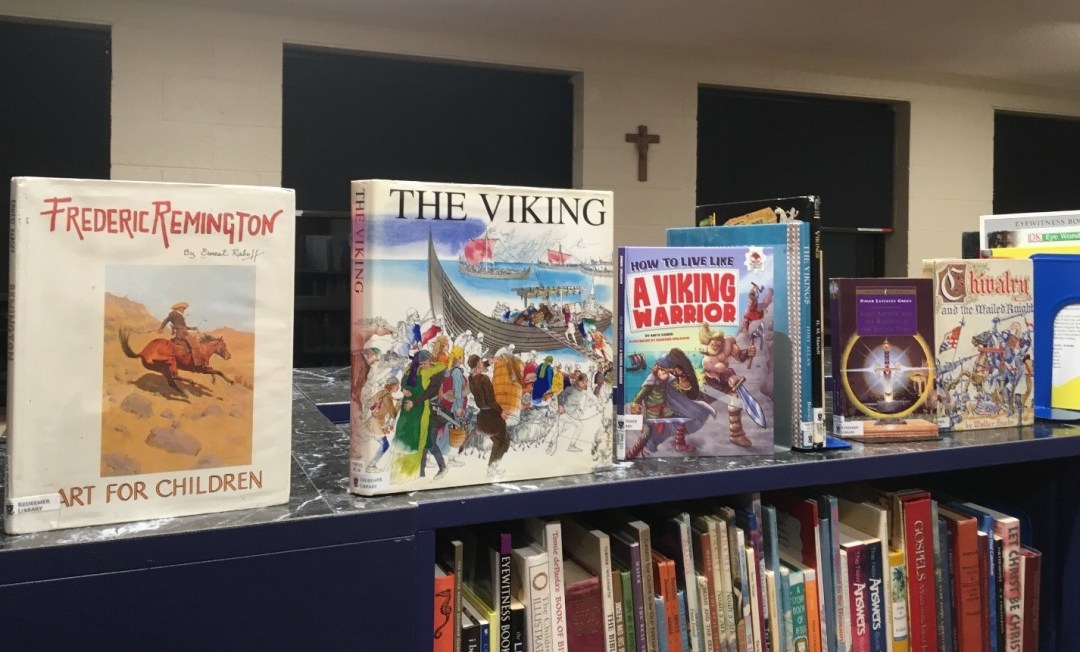Guest post from Redeemer parent and trusty library pack pony Nicole Schulert
It is very easy to go down the rabbit hole in the school library. What started as looking up some wintry bulletin board ideas led to finding a painting by Frederic Remington (1861 – 1909) entitled “The Fall of the Cowboy,” which originally accompanied an 1895 article that Owen Wister wrote in Harper’s Monthly called “The Evolution of the Cow-Puncher.”
Remington’s painting is held at the Amon Carter Museum of American Art in Fort Worth, Texas and depicts a pair of cowboys on a snow-covered plain. One has dismounted to open a fence. As the curator at the Carter Museum points out, “Remington’s painting has a somber, wistful tone conveyed by the muted colors of a winter scene – a palette in keeping with the artist’s intent to mourn the transformation of cowboy traditions.”
Curious about Wister’s article, I tracked it down and printed it out to read (digital rights are still held by Harper’s Monthly, so it can’t be shared online, but there’s a print copy on the bulletin board in the library). One of Wister’s thoughts is that you can trace a certain type of adventuring spirit from the Vikings, to the Medieval knights, to the American cowboys with their trusty steeds. For, “as he has ruled the waves with his ship from that Viking time, so upon land has the horse been his foster-brother, his ally, his playfellow, from the tournament at Camelot to the round-up at Abilene” (Wister 604).
Wister recognized that the ability “to survive in the clean cattle country require[d] a spirit of adventure, courage, and self-sufficiency” (604) and that in this particular breed of men, “their fighting Saxon ancestors awoke in them for a moment and made them figures for poetry and romance. . . .due to the strange accidents of a young country, where, while cities flourish[ed] by the coast and in the direct paths of trade, the herd-trading interior remain[ed] medieval in its simplicity and violence”(615).
But this way of life is not sustainable long-term. Indeed, “such existence soon makes a strange man of any one, and the early cow-punchers rapidly grew unlike all people but each other and the wild superstitious ancestors whose blood was in their veins” (615) and so many married and settled into farming or to town life, leaving those who could not acclimate to life in community to finish their days cattle rustling, gambling and, ultimately, facing the gallows.
Ironically, Wister worried that “this transient generation deserve[d] more chronicling than it will ever have” (615). Remington’s oeuvre is dedicated to preserving this chapter in history. Little did they suspect that the advent of the moving pictures and later television would immortalize and romanticize the cowboy in American life.
January’s book display is all about adventurers through the ages, “from the tournament to the round-up!” (Wister 606). Books on Vikings, knights, cowboys—and Frederic Remington—are all available for checkout. Enjoy!
“Such is the story of the cow-puncher, the American descendant of Saxon ancestors, who for thirty years flourished upon our part of the earth, and, because he was not compatible with Progress, is now departed, never to return” (Wister 617).
Sources:
“The Fall of the Cowboy.” The Fall of the Cowboy | Amon Carter Museum of American Art, www.cartermuseum.org/collection/fall-cowboy-1961230.
Wister, Owen, 1860-1938, and Frederic Remington. The Evolution of the Cow-puncher. New York: Harper, 1895.

